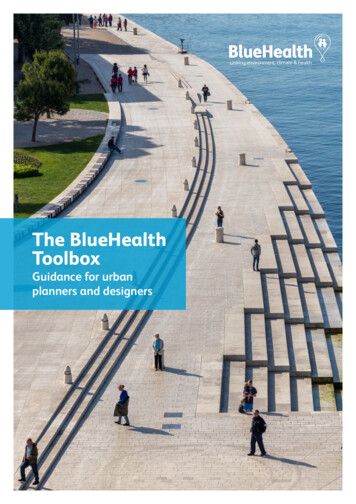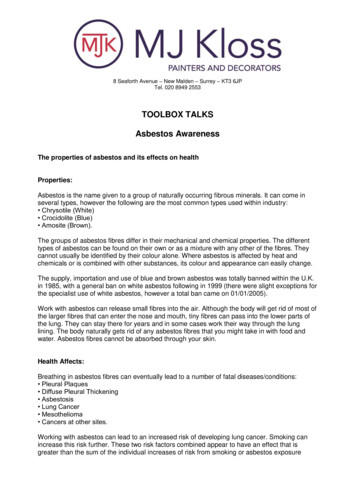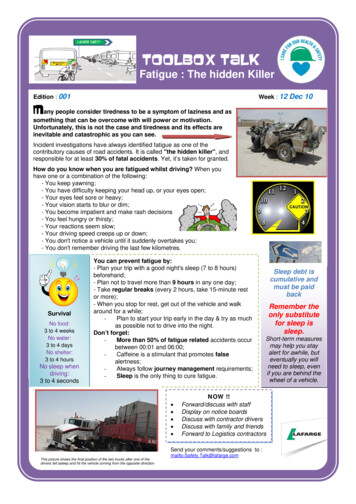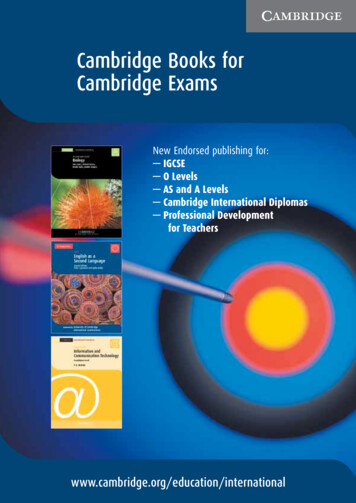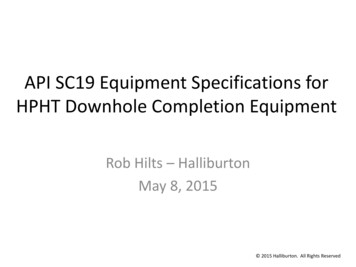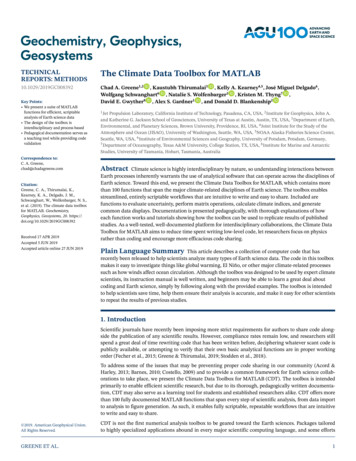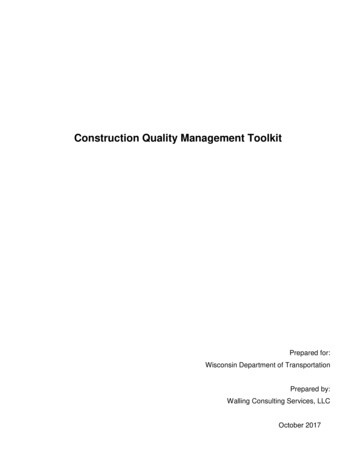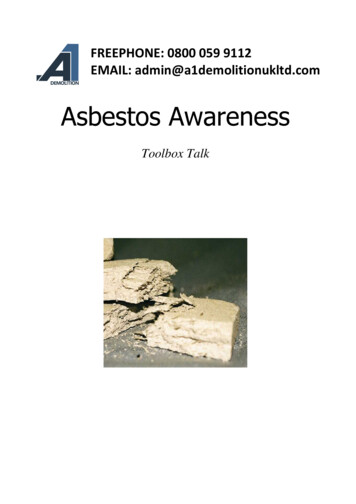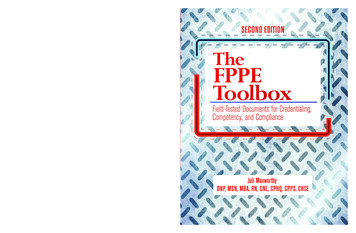
Transcription
The FPPE Toolbox: Field-Tested Documents for Credentialing, Competency, and ComplianceSECOND EDITIONThe FPPEToolboxField-Tested Documents forCredentialing, Competency, and ComplianceTJuli Maxworthy, DNP, MSN, MBA, RN, CNL, CPHQ, CPPS, CHSEhe second edition of The FPPE Toolbox: Field-Tested Documents for Credentialing, C ompetency, and Compliance provides an up-to-date, comprehensive resource for effective FPPE. This book p rovides compliant andcustomizable forms, policies, letters, scorecards, and reports that can be utilizedin facilities of all types and sizes. Author Juli Maxworthy, DNP, MSN, MBA, RN,CNL, CPHQ, CPPS, CHSE, shares her expert knowledge so MSPs can create a cohesive c ompetency documentation process at their organization.MaxworthyThis toolbox offers sample tools you can adapt for use in your own facility without making you wade through lengthy background information, including: FPPE policy documents Department-specific proctoring forms FPPE documents for HFAP-accredited facilities Forms that work for initial appointment and for-cause FPPE, and documents that illustrate the OPPE-FPPE connection A letter to a physician requesting his or her service as proctor Physician competency data scorecards Retrospective, concurrent, and prospective proctoring guidelinesFPPE229076 The FPPE Toolbox Cover 2nd ed Front and Back.indd 1a divisionof BLR100 Winners Circle, Suite 300Brentwood, TN 37027www.hcmarketplace.com5/19/15 3:34 PM
SECOND EDITIONTheFPPEToolboxField-Tested Documents for Credentialing,Competency, and ComplianceJuli MaxworthyDNP, MSN, MBA, RN, CNL, CPHQ, CPPS, CHSE
The FPPE Toolbox: Field-Tested Documents for Credentialing, Competency, and Compliance is published by HCPro, a division of BLR.Copyright 2015 HCPro, a division of BLRAll rights reserved. Printed in the United States of America.5 4 3 2 1ISBN: 978-1-55645-340-3No part of this publication may be reproduced, in any form or by any means, without prior writtenconsent of HCPro, or the Copyright Clearance Center (978-750-8400). Please notify us immediatelyif you have received an unauthorized copy.HCPro provides information resources for the healthcare industry.HCPro is not affiliated in any way with The Joint Commission, which owns the JCAHO and JointCommission trademarks.Juli Maxworthy, DNP, MSN, MBA, RN, CNL, CPHQ, CPPS, CHSE, AuthorMary Stevens, EditorErin Callahan, Senior Director, ProductElizabeth Petersen, Vice PresidentMatt Sharpe, Production SupervisorVincent Skyers, Design Services DirectorVicki McMahan, Sr. Graphic DesignerJason Gregory, Layout/Graphic DesignDoug Ponte, Cover DesignerAdvice given is general. Readers should consult professional counsel for specific legal, ethical, orclinical questions.Arrangements can be made for quantity discounts. For more information, contact:HCPro100 Winners CircleSuite 300Brentwood, TN 37027Telephone: 800-650-6787 or 781-639-1872Fax: 800-785-9212Email: customerservice@hcpro.comVisit HCPro online at www.hcpro.com and www.hcmarketplace.com
Table of ContentsAcknowledgments.vAbout the Author.viiIntroduction.ixChapter 1: Acadiana Management Group.1Figure 1.1: FPPE Protocol. 3Figure 1.2: FPPE/OPPE Quality Proctor Review Form. 6Figure 1.3: FPPE/OPPE Quality Proctor Review Form—On-Call/Alternate. 8Figure 1.4: FPPE Generic Peer Review Tool. 10Figure 1.5: Peer Review Profile Chart. 12Figure 1.6: Comparison of Joint Commission and HFAP FPPE/OPPE Standards . 14Chapter 2: Beebe Healthcare.17Figure 2.1: Initial Focused Professional Practice Evaluation Policy . 19Figure 2.2: FPPE Plan. 26Figure 2.3: Sample Evaluator Letter. 27Figure 2.4 Summary Report to Credentials Committee. 28Figure 2.5: FPPE Single Procedure Proctoring. 29Figure 2.6: FPPE Multiple Procedure Proctoring. 31Figure 2.7: FPPE Evaluation for Department of Anesthesia. 33Figure 2.8: Department of Medicine FPPE Retrospective Chart Review. 35Chapter 3: Care New England Health System.37Figure 3.1: FPPE Policy. 39Figure 3.2: FPPE Protocol Form . 41Figure 3.3: Credentials Committee Procedural FPPE. 43Figure 3.4: Credentials Committee Nonprocedural FPPE. 45Figure 3.5: FPPE Proctoring Assessment and Recommendation—Single Procedure. 46Figure 3.6: OB/GYN Supplemental Privilege Criteria for Robotic Surgery. 47Figure 3.7: OB/GYN Supplemental Privilege Criteria for Robotic Single-Site Surgery. 50 2015 HCProThe FPPE Toolboxiii
Chapter 4: Doctors Hospital of Manteca.53Figure 4.1: FPPE Policy and Procedure. 55Figure 4.2: FPPE/Proctorship Status Report. 61Figure 4.3: FPPE Evaluation/Proctorship Report for Practitioners Performing Invasive Procedures. 62Figure 4.4: FPPE Evaluation/Proctorship Report for Admitting Practitioners. 65Figure 4.5: FPPE Evaluation/Proctorship Report for Anesthesiologists. 67Figure 4.6: FPPE Evaluation/Proctorship Report for Surgical Practitioners. 69Figure 4.7: FPPE/Proctorship Report for Emergency Medicine Practitioners. 71Figure 4.8: FPPE/Proctorship Report for Pediatric Practitioners. 73Figure 4.9: FPPE/Proctorship Report for Consulting Practitioners. 75Chapter 5: Portneuf Medical Center.77Figure 5.1: Professional Evaluation Policy. 79Figure 5.2: Specialty-Specific FPPE Plans. 87Figure 5.3: FPPE Table. 91Figure 5.4: Sample FPPE Contract. 94Figure 5.5: Documentation of OPPE Results. 95Figure 5.6: FPPE Report. 96Figure 5.7: Monitoring Evaluation Form. 97Figure 5.8: Surgical Monitoring Report Form. 99Figure 5.9: Radiology Monitoring Evaluation Form. 101Figure 5.10: Monitoring Evaluation Form for Allied Health Providers.104iv
AcknowledgmentsHealthcare today is evolving at such a rate that it is difficult to keep track of it all. Practitioners’ patternsof practice are under more scrutiny today than they have ever been in the history of healthcare. The JointCommission, along with other accrediting bodies, are continually “turning up the heat” to ensure that providers are thoroughly evaluated prior to becoming part of the medical staff and that the organization regularly reviews defined metrics to ensure that only the best touch patients.Those fearless individuals who tirelessly work in quality management and medical staff offices have beendealing with the challenges of properly evaluating potential medical staff for many years. The arrival ofThe Joint Commission’s FPPE standards in 2007 provided the means by which to expand the importantwork of ensuring quality patient care. For most institutions, FPPE has made the onboarding process forpotential medical staff much more straightforward, but many institutions are challenged with developingFPPE for cases where provider practices are not occurring at the desired level of expertise and there is aneed for further review.The work of putting together these FPPE dashboards, which are full of data, is immense, and it reallytakes a village to put together something that is thoughtful and meaningful to all of those whom it affects.Because of changing standards of practice and technology, metrics are constantly being assessed and reassessed at prescribed intervals to ensure that FPPE reviews reflect current practice.This toolbox would not have been possible without contributing sites being willing to provide their formsand allowing us to ask questions about their processes so that their excellent examples could be bestdescribed.As for the author, she is always grateful to her husband, Dr. Gary Witherell, for his never-ending support;her parents; her sisters; and her children and daughters-in-law Cathy, Becka, Kati, Trevor, Miranda, andKaiti, who are amazing people that I am very proud to call my family. Many thanks to Mary Stevens atHCPro, who has been a wonderful partner in this endeavor. 2015 HCProThe FPPE Toolboxv
About the AuthorJuli Maxworthy, DNP, MSN, MBA, RN, CNL, CPHQ,CPPS, CHSEJuli Maxworthy, DNP, MSN, MBA, RN, CNL, CPHQ, CPPS, CHSE,brings nearly 30 years of nursing experience to her roles. Herlast clinical position was Vice President of Quality and Risk,where she had oversight of many of the activities of the medicalstaff. She has implemented OPPE and FPPE at the institutions inwhich she had oversight of the process. Through her work, shehas learned how challenging and rewarding the implementationof these processes can be for both the organization that is man dated to execute OPPE/FPPE to maintain accreditation and for themedical staffs that are trying to understand exactly what the mandates mean and how they are going tosuccessfully meet them.Dr. Maxworthy is the CEO of WithMax Consulting Inc., a healthcare consulting and medical writing company located in the San Francisco Bay area. In that capacity, she utilizes her extensive experience to helphealthcare organizations navigate these changing and challenging times. Dr. Maxworthy recently editedThe OPPE Toolbox for HCPro (October 2014) and co-edited a 60-chapter textbook titled Defining Excellencein Simulation Programs. She has spoken at the local, national, and international level on various healthcare topics. Dr. Maxworthy recently obtained a Certified Healthcare Simulation Educator (CHSE) credentialfrom the Society for Simulation in Healthcare. She is the chair for the Accreditation Committee for theSociety for Simulation, as well as Region One Coordinator for Sigma Theta Tau International.Dr. Maxworthy holds a doctorate in nursing practice and two master’s degrees (nursing and businessadministration). She is a certified professional in healthcare quality with the National Association ofHealthcare Quality as well as in patient safety from the National Patient Safety Foundation. She iscurrently an assistant professor at the University of San Francisco, where she is the chair of the Healthcare Leadership and Innovation Department, as well as director of the BSN to DNP and CompletionDNP programs. 2015 HCProThe FPPE Toolboxvii
IntroductionThe miracle is this: The more we share, the more we have.—Leonard NimoySince the days of Semmelweis and Nightingale, patient outcomes have been measured and evaluated.When The Joint Commission introduced focused professional practice evaluation (FPPE) in 2007, itformally prescribed that healthcare organizations must perform a review of practitioners on an ongoingbasis. Although this standard has been around for almost eight years, it is still challenging for institutionsto create meaningful data that reflects their practices.In 2014, the Healthcare Facilities Accreditation Program (HFAP) adopted its own standards for FPPE(3.15.02), as a Condition of Participation. The HFAP standard calls for additional, focused monitoringand evaluation of a practitioner’s professional performance and allows the medical staff to monitorperformance of an individual for a defined period of time, based on three indications:1. All new privileges granted by the board upon initial appointment2. All new/additional privileges granted by the board, following initial appointment3. Identification of issues affecting the provision of safe, high-quality patient care (HFAP, 2014)Whether used in concert with The OPPE Toolbox or on its own, The FPPE Toolbox provides examplesof useful FPPE activities as a way to support practitioner performance improvement. Efficient, effectiveevaluation of practitioners at the time of their initial appointment is critical to ensure that they will be anasset to the organization. If ongoing monitoring processes are robust, they can contribute to the early identification of trends, evaluation, and decision-making on the maintenance or adjustments of privileges ofa provider and proactive educational and collegial intervention if warranted. FPPE is a wonderful way toprovide an in-depth evaluation of a clinician who is seeking additional privileges; or, if opportunitiesfor improvement are identified, FPPE provides a systematic process in which evaluation can take place.The documents in this toolbox are intended to assist your organization in elevating the understandingof FPPE and complying with regulatory standards.The competency equation developed by the Greely Company states:Competency Evidence that you did it recently Evidence that you did it well 2015 HCProThe FPPE Toolboxix
Those reading this toolbox will note that organizations have defined “it” in a variety of ways. Most usethe regulatory standards as a starting point and then add elements that the medical staff has decided aremeaningful for their work.The tools in this book are intended to serve as a starting point for your organization’s own developmentof meaningful metrics that will drive improved quality of care. Many of these forms have been reviewedby regulatory agencies during the institution’s site visit and have received positive feedback. The JointCommission has even requested that some of these forms be included on its website of best practices.These documents will help you and your organization develop a transparent, meaningful, and easy-tounderstand process for your FPPE management. A spectrum of institutions is represented in these pages.As you move forward in refining your FPPE processes, we hope that the items in this toolbox will provideyour institution with the items that will elevate your practices to provide exceptional care to the patientswho come to your institutions for care. We encourage you and your teams not to “cut and paste” thesetools but rather use them as a starting point, taking into consideration the culture in which these changesand improvements will occur.The FPPE (and ongoing professional performance evaluation) process is only as valuable as each medicalstaff makes it. As a leader, it is imperative that you work within the confines of your institution and alwayskeep your goal to be either 0 or 100%.There is no finish line in quality.Editor’s note: These forms should serve as guidance to begin transforming or refining your FPPE process and forms. The forms are specific to the hospitals that created them and may not be applicableto your organization. Advice given is general. Always check your policies and procedures, bylaws, andother governing documents before taking advice from any of these forms.Many of the forms featured in this book are meant to be one-page dashboards. Because of space constraints, they appear over multiple pages in the book with gray shading. When you download theseforms, you will see it makes sense to keep these forms as one-page dashboards, because doing so makesit easier for reviewers to complete or review.x
Chapter 1Acadiana Management GroupThe Healthcare Facilities Accreditation Program (HFAP) standards for FPPE and OPPE, which went intoeffect in 2015, aren’t that different from The Joint Commission standards. The FPPE and OPPE requirements shouldn’t intimidate HFAP-accredited facilities, according to Susan Wallis, RHIT, CHC, Director ofHealth Information Management and HIPAA Privacy and Security Officer at Acadiana Management Group(AMG), in Lafayette, Louisiana.AMG manages an HFAP-accredited long term acute care hospital (LTACH) in Central Indiana and severalJoint Commission-accredited hospitals in a number of states, and Wallis developed FPPE forms for usesystemwide. From a compliance perspective, the HFAP requirements for FPPE and OPPE provide a detailedexplanation which allows for easy understanding of the requirements. “We were able to mirror our current[Joint Commission FPPE] process, and it works well,” she says.AMG’s FPPE process consists of two types of reviews, invasive procedure and clinical quality for all newprivileges granted, which includes initial appointment or requests for additional privileges. LTACHstypically do not perform a large volume of invasive procedures. “There are only a handful of proceduresthat are performed in our hospitals such as excisional debridements, tracheostomies, and central venouscatheter insertions.”“Clinical quality reviews are the bulk of what is used for the FPPE process in our setting,” Wallis adds.“We monitor the overall quality of care that’s being provided for every licensed independent practitioner[LIP] that renders care in our hospitals. The quality review consists of appropriate management of complications, use of diagnostic tests, daily LIP visits, effective communication, among other things,” says Wallis.LIPs who do not meet the minimum FPPE review criteria (two reviews for each invasive procedure privilege requested and two reviews for clinical quality) during their two-year reappointment cycle will remainunder FPPE until the criteria is met. “Removal from FPPE is privilege-specific, meaning we may be able toremove them from FPPE for clinical quality, but they may still remain under FPPE for a specific procedure,until the minimum review requirements are met,” Wallis adds.“At the end of the day, the FPPE/OPPE process has to be something that a smaller facility can handle with[limited] staff.”AMG’s FPPE/OPPE data are collected and reported to the LTACH Medical Executive Committee (MEC).Data then flow up to the Governing Board. The Governing Board representatives at the facility level consistof the CEO and Medical Director. 2015 HCProThe FPPE Toolbox1
Chapter 1The OPPE process may trigger a for-cause FPPE if an LIP is identified with an issue affecting the provisionof safe patient care or with an unusual clinical practice pattern. “In this case, the MEC also has the abilityto place an LIP under a period of FPPE,” Wallis says. Unbiased chart review can be a challenge, so whennecessary, AMG uses external physicians with whom it has contracts and business associate agreements,but who may practice in a different hospital or state.“The HFAP surveyors liked our FPPE/OPPE Tracking Log. The log is utilized to track the peer review datacollected within one tool. All LIPs that are granted privileges are added to the tool. As reviews are performed, the number of reviews per LIP are inserted to ensure we have data that’s readily available. Thedetailed data is found in each LIP’s quality file. The tracking log plays a vital role in OPPE as well.” Thelog is available in the downloadable files and forms for this book.Wallis has been in the LTACH arena since 1994 and joined AMG in August 2011. She says FPPE and OPPEhave value in LTACHs because the process allows the hospital to confirm the competence of each LIP andensures competence is maintained, which in turn has a positive effect on quality outcome data. The process also guarantees that physician-specific data is being analyzed periodically during their privilege cycle.“Most issues are found to be documentation- and/or communication-related, not necessarily quality ofcare,” she says.Wallis urges HFAP-accredited sites building their FPPE and OPPE process to utilize data they may alreadybe collecting. “You don’t have to reinvent the wheel; you’re able to utilize a lot of data that you alreadycollect, it’s just drilling it down so it’s physician-specific. Get credit for what you’re already doing, thenimplement the additional forms and tools that you need to get the privilege-specific data collected,” sheadvises.2
Acadiana Management GroupFigure 1.1FPPE ProtocolThis protocol applies to all the LTACHs that are part of the AMGsystem. “Centralizing” information in one location can save time forfacilities seeking information about FPPE.FOCUSED PROFESSIONAL PRACTICE EVALUATION (FPPE)1. Triggers for Performance MonitoringA. New practitioners appointed to the medical staff for all initially requested privilegesB. Any existing practitioner with modification of privileges (including new privileges added)C. Any practitioner identified with an issue affecting the provision of safe, high-qualitypatient care or with an unusual clinical pattern of careD. Sentinel event or near miss (requires root cause analysis)2. Components of the Performance Monitoring ProcessA. Proctoring/chart review shall be conducted on a minimum of two cases for new practitioners, those with modification and addition of new privileges, or those with identifiedquality concerns.B. A more extensive period of time or number of cases may be specified by the medicalexecutive committee (MEC) for a total proctoring/review period not to exceed the provisional term, or in the case of existing members, for a period not to exceed 24 months.The MEC may establish a longer period of time and/or greater number of cases and/or specific number of cases applicable to the particular clinical privileges involved afterevaluating the practitioner’s current clinical competence, practice behavior, and abilityto perform the requested privilege. Other existing privileges in good standing shouldnot be affected by this decision.C. Sentinel events require immediate review within 72 hours of identification with action/decision within 45 days of the event. A “near miss” will be reviewed within 72 hoursof identification and will be reported at the next MEC.D. Proctoring/review shall be performed by one proctor/reviewer who has no professionalrelationship with the practitioner being proctored/reviewed.E. The proctoring/reviewing process shall not violate the doctor/patient relationship andmust conform to the applicable portion(s) of the MEC.F. Direct/concurrent proctoring or retrospective (chart review) will be utilized3. Requirements of the Proctor/ReviewerA. The proctor/reviewer shall be assigned by the medical directorB. It is the responsibility of all members of the medical staff to proctor/review when askedto do soC. An external reviewer will be utilized if there is a lack of internal expertise or conflictof interest 2015 HCProThe FPPE Toolbox3
Chapter 1Figure 1.1FPPE Protocol (cont.)4. Items to Be Proctored/ReviewedThe overall conduct of the care of the patient will be assessed by evaluating at least the following aspects of care:A. Clinical/cognitive:1. Timeliness of rounds2. History and physical (H&P) examination3. Accuracy and completeness of progress notes4. Complications5. Completeness and readability of documentation6. Appropriate use of diagnostic tests and procedures7. Appropriate use of consultants8. Communication skills9. Professional demeanorB. Invasive:1. Indications for procedure2. Preoperative management and assessment3. Technique4. Postoperative management5. Consent and time-out forms for invasive proceduresThese forms areprovided later in thissection.FPPE Procedure1. All new practitioners (physicians, NPs, or PAs) granted initial privileges, existing practitioners granted new privileges, practitioners with an identified quality concern, or practitioners with a sentinel event or near miss will be under a period of focused review fora minimum of the first two procedures for each privilege granted.2. Centralized credentialing will forward a list of all new privileges required to be focusreviewed and these specific privileges should be added to LIP peer profile under thefocused review section and to the FPPE/OPPE tracking log. Example: Granted excisionaldebridement and central line privileges: The first two debridements and the first twocentral lines have to be reviewed by the physician reviewer using Invasive Proceduresand Quality Review forms for those without privileges for invasive procedures and thePlease see thefindings forwarded to the MEC for review. The MEC will then decide whether to removeforms followingthe focused review or extend the number of reviews. As each minimum number is rethis policy for the viewed, the data can be submitted to the MEC. You do not have to wait on all privilegesexample.to meet the minimum review requirement to submit the data to the MEC it can be submitted on a privilege-by-privilege basis.3. For practitioners identified with a quality concern, sentinel event, or near miss, the nursereviewer will utilize the Generic Review form and conduct a review of the issue. This willthen be reviewed by the physician reviewer and forwarded to the MEC for recommendation. The MEC may decide to place the physician on a period of focused review.4The FPPE Toolbox 2015 HCPro
Acadiana Management GroupFigure 1.1FPPE Protocol (cont.)4. If at the end of the physician’s initial appointment period he or she has not performedthe minimum number of procedures to be removed from focused review, the MEC shalleither decide to keep the physician under focused review or recommend to remove theprivileges. If at the end of the reappointment period a physician has still not performedthe minimum number of procedures, it should be the recommendation of the MEC toremove the privileges due to nonuse and inability to deem competent.A copy of all completed reviews shall be placed in the physician’s quality file.Ongoing professional practice evaluation is factored into the decision to maintain existingprivilege(s), to revise existing privilege(s), or to revoke an existing privilege prior to or at thetime of renewal.Criteria Used in the Ongoing EvaluationThe following criteria approved by the medical staff are used in the OPPE and are acquiredfrom chart review:uu Review of operative and other invasive proceduresuu Blood usage and appropriatenessuu Morbidity and mortality datauu Documentation qualityuu Admission denials1. Monthly, using the MRR tool, enter medical staff-specific information in the PeerReview Profile for applicable MRR indicators.2. For practitioners that do not perform procedures regularly or have data as it relates toNo. 3 below, a minimum of two records should be reviewed biennially, or 100%, usingthe Quality Proctor/Review Tool. Alternate/On-call LIPs who have only progress notescan be reviewed using the Generic Proctor/Review tool.3. All invasive procedures performed in-house, transfers, mortalities, and blood transfusions are to be reviewed first by the nurse reviewer and then reviewed by the reviewingphysician (IM or UM function advisor). The following forms should be utilized:uu Invasive proceduresuu Transfersuu Mortalitiesuu Blood transfusionsThese forms were not included inthe form section because they arespecifically for OPPE.4. All review numbers should be entered on the FPPE/OPPE tracking log and the individual LIP peer profile in the proper section (for example: “blood transfusions: 2/2” two performed, two justified). Any invasive procedures should be entered on the profileunder “Procedures.”5. Cop
100 Winners Circle, Suite 300 Brentwood, TN 37027 www.hcmarketplace.com a division of BL R The FPPE Toolbox: Field-Teste

